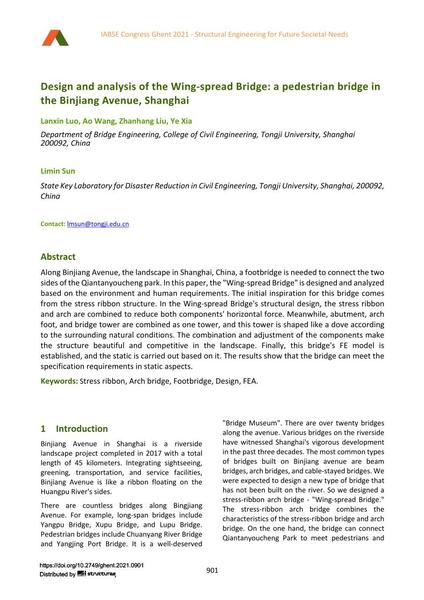Design and analysis of the Wing-spread Bridge: a pedestrian bridge in the Binjiang Avenue, Shanghai

|
|
|||||||||||
Bibliographic Details
| Author(s): |
Lanxin Luo
(Department of Bridge Engineering, College of Civil Engineering, Tongji University, Shanghai 200092, China)
Ao Wang (Department of Bridge Engineering, College of Civil Engineering, Tongji University, Shanghai 200092, China) Zhanhang Liu (Department of Bridge Engineering, College of Civil Engineering, Tongji University, Shanghai 200092, China) Ye Xia (Department of Bridge Engineering, College of Civil Engineering, Tongji University, Shanghai 200092, China) Limin Sun |
||||
|---|---|---|---|---|---|
| Medium: | conference paper | ||||
| Language(s): | English | ||||
| Conference: | IABSE Congress: Structural Engineering for Future Societal Needs, Ghent, Belgium, 22-24 September 2021 | ||||
| Published in: | IABSE Congress Ghent 2021 | ||||
|
|||||
| Page(s): | 901-908 | ||||
| Total no. of pages: | 8 | ||||
| DOI: | 10.2749/ghent.2021.0901 | ||||
| Abstract: |
Along Binjiang Avenue, the landscape in Shanghai, China, a footbridge is needed to connect the two sides of the Qiantanyoucheng park. In this paper, the "Wing-spread Bridge" is designed and analyzed based on the environment and human requirements. The initial inspiration for this bridge comes from the stress ribbon structure. In the Wing-spread Bridge's structural design, the stress ribbon and arch are combined to reduce both components' horizontal force. Meanwhile, abutment, arch foot, and bridge tower are combined as one tower, and this tower is shaped like a dove according to the surrounding natural conditions. The combination and adjustment of the components make the structure beautiful and competitive in the landscape. Finally, this bridge's FE model is established, and the static is carried out based on it. The results show that the bridge can meet the specification requirements in static aspects. |
||||
| Keywords: |
design arch bridge footbridge stress ribbon FEA
|
||||
| Copyright: | © 2021 International Association for Bridge and Structural Engineering (IABSE) | ||||
| License: | This creative work is copyrighted material and may not be used without explicit approval by the author and/or copyright owner. |
||||
